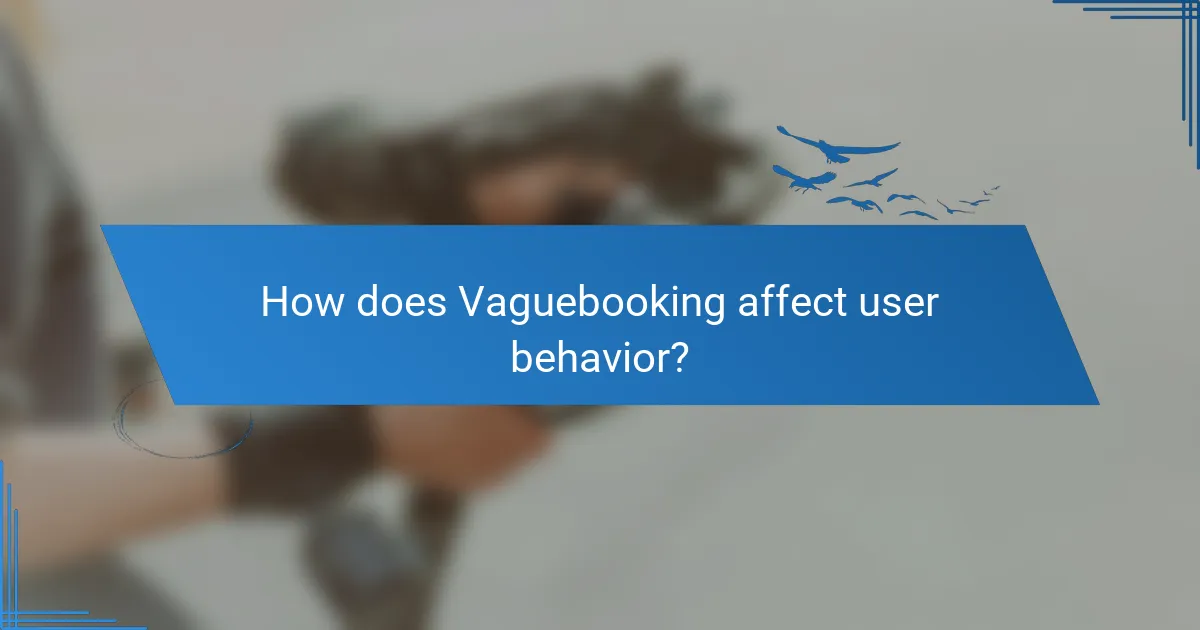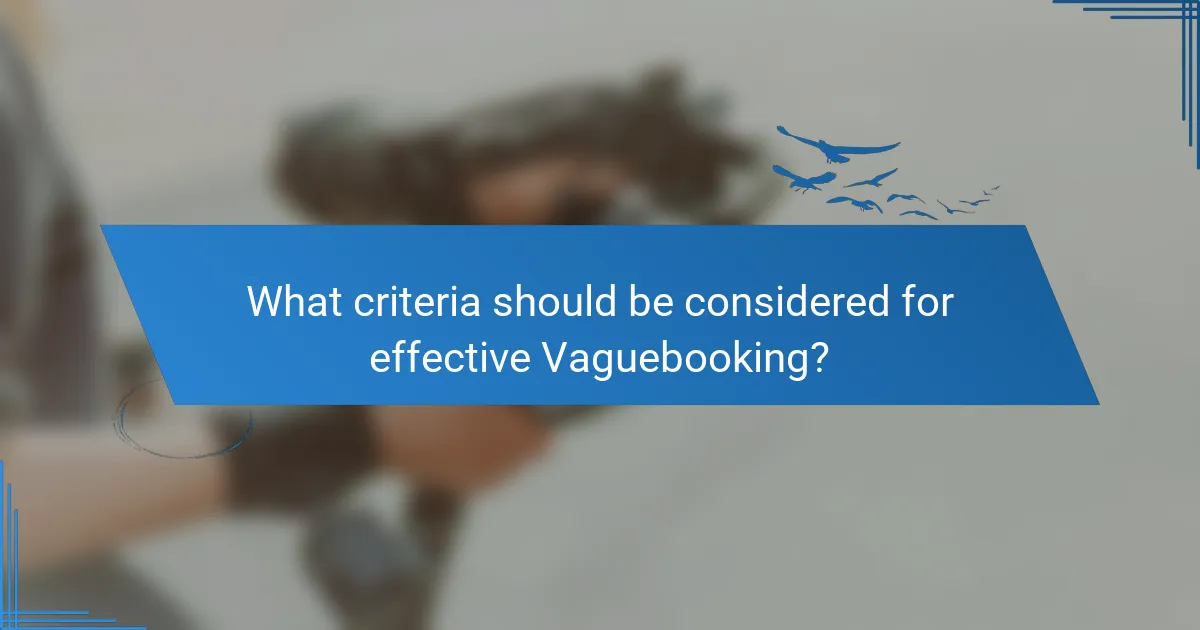Vaguebooking is a social media phenomenon where users share ambiguous or cryptic messages to stimulate engagement and interaction within online communities. This practice not only fosters a sense of connection among individuals but also enhances community engagement by inviting shared experiences and emotional resonance. By employing effective interaction techniques such as open-ended questions and visual cues, vaguebooking can significantly enrich the overall social dynamics of online platforms.

How can Vaguebooking enhance community engagement in Canada?
Vaguebooking can enhance community engagement in Canada by creating a space for shared experiences and emotional resonance among users. This technique encourages individuals to post ambiguous or cryptic messages that invite responses, fostering a sense of connection and interaction within online communities.
Increased emotional connection
Vaguebooking often taps into shared feelings or experiences, allowing community members to relate to one another on a deeper emotional level. When users post vague updates, it can evoke curiosity and empathy, prompting others to reach out and offer support or share their own stories.
For instance, a post like “Feeling overwhelmed today” can lead to numerous comments from friends expressing concern or sharing similar feelings. This emotional exchange strengthens bonds and creates a supportive atmosphere within the community.
Encourages discussions and interactions
The ambiguous nature of vaguebooking prompts users to engage in discussions, as they seek clarification or wish to express their thoughts. This interaction can lead to lively conversations, where members share insights or advice related to the original post.
For example, a vague post about “needing a change” might spark a discussion about life transitions, encouraging others to share their experiences or suggestions. This back-and-forth not only increases engagement but also enriches the community’s collective knowledge.
Fosters a sense of belonging
By participating in vaguebooking, individuals often feel more connected to their community, as they share personal experiences and receive feedback. This mutual sharing fosters a sense of belonging, making members feel valued and understood.
In Canadian online communities, where cultural diversity is prominent, vaguebooking can bridge gaps between different backgrounds, allowing users to find common ground through shared emotions and experiences. This inclusivity can enhance overall community cohesion and support.

What interaction techniques are effective for Vaguebooking?
Effective interaction techniques for vaguebooking include open-ended questions, subtle prompts for responses, and the use of emojis and visual cues. These methods encourage engagement and foster a sense of community among users, enhancing the overall interaction experience.
Open-ended questions
Open-ended questions are a powerful tool in vaguebooking as they invite users to share their thoughts and feelings without restrictions. For instance, asking “What’s been on your mind lately?” allows for diverse responses and deeper engagement.
When crafting these questions, aim for clarity and relevance to the context of the post. Avoid leading questions that may limit responses. Instead, focus on inquiries that encourage reflection and personal expression.
Subtle prompts for responses
Subtle prompts can effectively nudge users to engage without overtly asking for a response. Phrases like “I wonder what others think about this…” can create a sense of curiosity and encourage interaction.
Consider using hints or references to shared experiences within the community to make these prompts more relatable. This technique helps maintain a casual tone while still inviting dialogue among users.
Use of emojis and visual cues
Emojis and visual cues can enhance vaguebooking posts by adding emotional context and making them more relatable. A well-placed emoji can convey feelings that words alone might not capture, such as confusion or excitement.
When using emojis, choose those that resonate with your audience and the message you want to convey. For example, a simple smiley face can lighten a serious post, while a question mark can indicate uncertainty, prompting others to engage and share their thoughts.

What are the social dynamics of Vaguebooking?
Vaguebooking refers to the practice of posting ambiguous or unclear messages on social media, often to elicit responses or engage others. The social dynamics of vaguebooking revolve around how these posts create interaction opportunities and influence community engagement.
Influence of anonymity on engagement
Anonymity can significantly enhance engagement in vaguebooking, as users feel less pressure to reveal their identities. This can lead to more candid responses and a greater willingness to share personal experiences or opinions without fear of judgment.
However, the lack of accountability may also result in negative interactions, such as trolling or harmful comments. Communities should establish guidelines to promote respectful discourse while allowing for anonymous participation.
Impact on group cohesion
Vaguebooking can both strengthen and weaken group cohesion. On one hand, shared vague posts can create a sense of belonging and mutual understanding among members, fostering deeper connections. On the other hand, if posts are perceived as attention-seeking or insincere, they may alienate members and disrupt group harmony.
To maintain cohesion, groups should encourage clarity and sincerity in posts while allowing for some ambiguity that invites discussion. Regularly addressing vague posts can help mitigate misunderstandings and promote a supportive environment.
Role of social validation
Social validation plays a crucial role in the dynamics of vaguebooking, as users often seek affirmation through likes, comments, and shares. This desire for validation can drive individuals to post more frequently, even if the content lacks substance.
Encouraging constructive feedback rather than mere validation can enhance the quality of interactions. Groups might consider implementing systems that reward thoughtful engagement, helping to shift the focus from superficial approval to meaningful connections.

How does Vaguebooking affect user behavior?
Vaguebooking influences user behavior by encouraging ambiguous posts that invite speculation and engagement. This phenomenon often leads to increased interaction as users seek clarification or express concern, altering the dynamics of online communication.
Increased posting frequency
Vaguebooking tends to increase the frequency of posts among users. By sharing cryptic messages, individuals often feel compelled to post more regularly to maintain engagement and curiosity among their followers. This can lead to a cycle where users continuously seek attention through ambiguous updates.
For example, a user might post a vague status about feeling “off” or “conflicted,” prompting friends to comment and ask for more details. This interaction can encourage the user to post even more frequently to keep the conversation going.
Shifts in content sharing
The nature of vague posts can shift the type of content shared on social media platforms. Users may begin to favor emotional or ambiguous content over straightforward updates, as the former tends to generate more reactions and comments. This shift can create a culture where clarity is less valued than intrigue.
As a result, users may share less personal or informative content, opting instead for posts that provoke questions or speculation. This can lead to a less informative social media environment, where users focus more on engagement than on sharing meaningful information.
Variations in audience reactions
Audience reactions to vaguebooking can vary significantly, ranging from concern to annoyance. Some users may feel compelled to reach out and offer support, while others might find the ambiguity frustrating and disengage from the conversation. This dichotomy can impact the overall tone of interactions on social media.
For instance, a post that hints at personal struggles may elicit a wave of supportive comments, while a vague statement about a “big decision” could lead to mixed reactions, with some users expressing curiosity and others questioning the need for such ambiguity. Understanding these varied responses is crucial for users looking to navigate social dynamics effectively.

What are the risks associated with Vaguebooking?
Vaguebooking can lead to various risks, including misunderstandings, negative impacts on mental health, and privacy concerns. These issues arise from the ambiguous nature of vague posts, which can provoke confusion and unintended consequences among friends and followers.
Potential for misunderstandings
Vaguebooking often creates a breeding ground for misinterpretation. When users post ambiguous messages, their friends may speculate about the meaning, leading to confusion and unnecessary drama. For example, a post like “Feeling lost today” might prompt friends to worry excessively or offer advice that is not needed.
To minimize misunderstandings, consider being more specific in your posts. Instead of vague statements, sharing clear thoughts or feelings can foster better communication and reduce the chances of misinterpretation.
Impact on mental health
The emotional toll of vaguebooking can be significant. Users may feel isolated or misunderstood when their posts do not receive the expected support or engagement. This can lead to feelings of anxiety or depression, especially if the vague post was intended to seek help.
To protect mental health, it is advisable to communicate openly with trusted friends or family rather than relying on vague social media posts for support. Engaging in direct conversations can provide more meaningful connections and alleviate feelings of loneliness.
Privacy concerns
Vaguebooking can inadvertently expose personal information, raising privacy issues. When users share ambiguous posts, they may reveal more than intended, allowing others to piece together sensitive details about their lives. For instance, a post about “dealing with a tough situation” might lead others to speculate about personal matters.
To safeguard privacy, consider adjusting your social media settings to limit who can see your posts. Additionally, think carefully about the implications of your words before posting, ensuring that you do not disclose information that could compromise your privacy.

What criteria should be considered for effective Vaguebooking?
Effective Vaguebooking hinges on several key criteria, including clarity, engagement, and emotional resonance. By balancing ambiguity with enough context, users can foster interaction while maintaining a sense of mystery.
Clarity in Messaging
While Vaguebooking thrives on ambiguity, clarity is essential to ensure that the audience understands the emotional tone. Use language that evokes curiosity without being overly cryptic. For instance, instead of saying, “I’m done with this,” consider a more engaging approach like, “Some changes are coming that I can’t wait to share.”
Clear messaging invites responses and encourages others to engage. Aim for a balance where the post is intriguing yet understandable, prompting followers to ask questions or share their thoughts.
Engagement Techniques
To maximize engagement, consider using questions or prompts that invite interaction. Phrasing like, “Ever felt like this?” or “Can anyone relate?” encourages followers to share their experiences. This creates a community feeling and enhances the post’s reach.
Additionally, timing plays a crucial role. Posting during peak hours when your audience is most active can significantly increase interaction rates. Monitor engagement patterns to identify the best times for your audience.
Emotional Resonance
Vaguebooking should evoke emotions that resonate with your audience, fostering a sense of connection. Posts that touch on universal feelings such as nostalgia, frustration, or joy tend to perform better. For example, sharing a vague yet relatable sentiment like, “Some days are just harder than others,” can elicit empathy and support.
Be mindful of the emotional tone you set. Positive vibes can uplift your audience, while more somber tones may invite support and solidarity. Tailor your message to reflect the emotional state you wish to convey.
